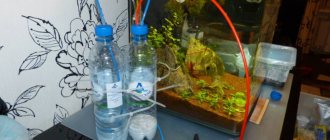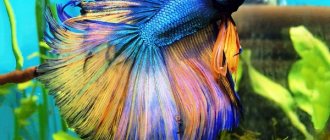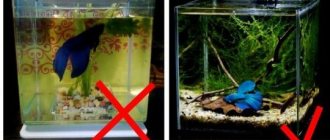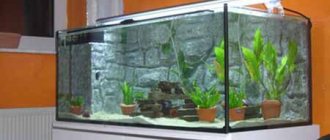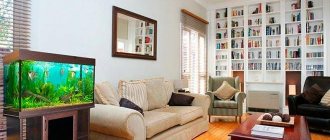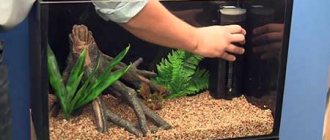Home › Aquarium care ›
( 2 ratings, average: 4.00 out of 5)
Are you already familiar with the expression “natural aquarium” or “natural aquarium” by Takashi Amano? If not, I recommend that you first familiarize yourself with the works of this famous Japanese aquascaper and be inspired by them. Because this article is about how to start a natural aquarium with live plants from scratch according to all the rules of Takashi Amano on the nutritious soil of Ada Amazonia. There will be a lot of BUKOFF, but even more photos, detailed step-by-step information on what to use, how to pour it, what decorations to use, live plants, equipment, what animals to add to your natural aquarium. If you are a beginner and just want to try yourself in both aquarium keeping and aqua design, follow these instructions and everything will work out!
Stage 1 - installation of the aquarium
For example, we will consider a branded aquarium from Hell with a length of 60 cm: ADA CUBE GARDEN 60-P . This is, of course, a very expensive aquarium (about 115 euros) and not everyone can afford it, and it’s not easy to find it on sale, but this super-aquarium made of ultra-transparent glass will allow you to truly enjoy its contents.
Dimensions: 60X30X36CM (64 liters).
To install the aquarium, choose a smooth, level surface that is strong enough to support a weight of more than 60 kg. Make sure the surface is level using a level.
Place a mat (aquarium mat) on the selected surface. Garden Mat is recommended for this aquarium .
Stage 2 - ADA Ground, Living System
The soil is the place where aquatic aquarium plants spread their roots and receive nutrients. Bacteria and microorganisms live in the soil, working as a biological filter.
The soil in our natural aquarium will consist of organic and inorganic compounds. “Living soil” means that it will be enriched with living bacteria, which will create a symbiosis with the roots of the plants. Inorganic compounds will be absorbed by plants through the roots. Living soil is our guarantee to get your aquarium up and running quickly.
- Powder of ADA Bacter 100 - more than 100 species of bacteria and beneficial microorganisms.
- A thin layer of ADA Clear Super is an activated carbon powder mixed with some beneficial substances. The powder promotes the growth of nitrifying bacteria.
- On top of the substrate is ADA Power Sand Special-S - base substrate material with the addition of organic nutrients, a layer of up to 1 cm.
- All this is covered with a thick layer (4-7 cm) of nutrient soil ADA Aqua Soil Amazonia .
The usual primer ADA Aqua Soil Amazonia will be used here, but there are several options:
- Aqua Soil-Amazonia is a material rich in organic acids and nutrients that promotes the growth of roots of aquatic plants. Together with Power Sand , it becomes an ideal substrate for plants.
- Ada Amazonia light (Aqua Soil-Amazonia LIGHT) - thanks to the natural color of the earth, it looks visually more natural.
- Ada Malaya (Aqua Soil-Malaya) is an ocher-colored soil that imitates soils in Southeast Asia. Suitable for longer use.
- Ada Africana (Aqua Soil-Africana) is a soil the color of the reddish earth of Africa. The amount of organic matter is less than in Ada Amazonia, so plants grow more slowly in this soil. Also suitable for longer use.
Level the soil, creating a straight line. The anterior edge has a thinner layer, and the posterior edge has a thicker layer. The slope from the back wall to the front creates an additional sense of depth in a natural aquarium.
Production and composition of aquasoils
Before the advent of branded products, aquarists had two options: use regular soils, performing a preliminary procedure of mechanical cleansing and disinfection, or periodically add liquid fertilizers to the water.
However, the first method cannot provide the proper level of sanitation and performance characteristics, and the second still does not allow the roots of aquarium plants to act as they would in natural conditions.
The first to put aquasoil production on an industrial scale were the Japanese.
A natural component - real layers of soil taken from fertile areas - became the basis for nutrient soils.
True, in order to become aquasoils with high performance characteristics, they will have to go through several stages of processing.
Oliver Knott
famous aquarium designer from Germany
If we talk about ADA soils, they are mined directly on the islands, fortunately there are plenty of them in Japan. Production takes place in the northern regions - they are less populated, and the infrastructure does not interfere with production. ADA also adds soil from tropical forest regions - hence the high price of Aqua Soil
— Oliver Knott, famous aquarium designer from Germany
- After the soil masses are delivered to production, they pass through several screening sieves. At the first stage, large pieces that cannot be crushed are rejected, and at the end a mass more homogeneous in dispersion emerges.
- Next, the earth mass is fired in a kiln. Temperatures reach 400 degrees Celsius. During this procedure, any pathogens and other microorganisms that may remain in the soil are killed. Repeated calcination occurs at 200 degrees.
- By this time, the composition is granulated, the particles acquire a rounded shape, as if sintering inside - this will provide them with mechanical resistance.
- In order to make the soil more stable and cohesive, various plastic clays, such as bentonite, are used. Sometimes volcanic soils are used, which are abundant in Japan itself. To increase the properties that promote plant growth, additional substances can be added to the composition of aquasoils.
| Humates | Salts of humic acids accelerate plant growth under water and on land by conditioning and detoxifying the soil |
| Lignite | Parts of fossil plants turned into brown coal under pressure disinfect water |
| Diatomite | Mineral from the shells of diatoms. natural antiseptic and conditioner, well adsorbs applied liquid fertilizers. |
Stage 3 - creating a model of a natural aquarium
The basis of the composition will be pre-prepared driftwood. Place it as you see fit: in the center, to the right, to the left, closer to the back wall. You create a natural aquarium to your taste; driftwood can be positioned as you like, they can be replaced with stones or rock fragments. All this will be complemented by living plants. In the example, aquatic moss will grow on the driftwood.
At this stage, your task is to give “your own character” to your future natural style.
Three main compositions
In aquadesign, three main composition models for a Natural Aquarium are used: triangular, convex and concave. They are easy to create and are good for beginners to try out in an aquarium with live plants.
Convex
The most complex of the three main compositions. The most important thing in it is to maintain a balance between the right and left open space.
Concave
A very popular composition for an aquarium with live plants. Make sure there is some open space in the center.
Triangular
A composition with wider open space on the right or left side. Pay attention to the angle of the driftwood, which makes up the hypotenuse of the triangle.
Stage 4 - planting living foreground plants
It is easier to plant aquarium ground cover plants in nutrient soil when it is wet. In this case, there is less chance that the plants will float. Therefore, before planting, fill the aquarium with water so that it barely covers the soil. It is more convenient to plant plants with long tweezers.
You can select plants for the foreground from the catalog.
Preparation for planting depends on the chosen plant; you will find all this in the description of the plants. Typically, in specialized stores, plants are sold in bunches and before planting they need to be divided into separate independent individuals.
Ground cover plants are introduced into the soil using tweezers at an angle - this prevents subsequent emergence. Special tweezers from Ada are sold for professionals - very comfortable, ideal for planting.
The snag, as already mentioned, was previously covered with moss (willow moss was used). Any moss can be used for any composition.
Purpose of aquasoils
Aquarium fish do quite well with the simplest classical type of soil - sand and gravel, which cannot be said about aquarium plants. In these types of fillers, the root system has nowhere to take root, so good growth and development cannot be expected.
Nutrient substrates were originally developed for keeping shrimp, since these crustaceans not only required keeping in a well-planted aquarium, but also absorbed detritus, which was practically absent when monocultured in aquariums with inorganic substrate.
The main difference between nutrient substrates and inert soils is their ability to influence the acid-base balance of water. More acidic water is suitable for underwater plants because it holds more carbon dioxide, which is used in photosynthesis.
Today, the environment for using aquasoils is aquarium growers. It is the breeding of aquatic plants and aquascaping that require special conditions for the growth of living objects in the aquarium landscape.
At the same time, the presence of fish is not completely excluded, however, in many types of aquarium gardens, Dutch and Japanese, they are assigned a secondary role. Those who raise shrimp in aquariums make up another part of the users of nutrient soils.
Stage 5 - planting living plants in the middle ground
In a natural aquarium, a smooth transition is created from foreground plants to background plants. Long-stemmed plants are most often (and in our case) used to create a background. In the middle of our example, the plants may find themselves in the shade of a snag, so it is better to choose shade-loving plants. For the middle ground we will use cryptocorynes and epiphytes - plants that have almost no roots and therefore can be tied to driftwood (anubias, water ferns, bucephalandras).
Epiphytic plants are applied to the snag and tied in the right place using fishing line or nylon thread.
- Fern bolbitis gedeloti.
- Cryptocoryne albida, Cryptocoryne poetsch, Cryptocoryne wendta brown.
- Thai angustifolia fern.
Stage 6 - background plants
Long-stemmed plants are usually chosen for the background, and the balance of color and leaf shape is important in the choice.
Hygrophila multisperma, Ludwigia arcuata, Rotala makrandra (green), Rotala indica, Hemianthus micranthemoides will be used.
At point 1, Hydrophila polysperma, Ludwigia arcuata, Rotala macrandra (green) are planted; plants with red leaves, like rotala indica, mostly towards the center.
The height of plants when planting should be as level as possible.
Hemianthus micranthemoides has thin, narrow leaves; it is better to plant it in bunches of several stems. To get a dense and neat layer, plants need to be planted at an angle, against the direction of the soil.
After planting, the aquarium is filled with water to the brim. You can place your hand under the stream so as not to disturb the ground. If the water is very cloudy, you can drain it and add fresh water.
Use a water dechlorinator such as ADA Aqua Conditioner Chlor-Off.
Stage 7 - equipment installation
The final stage of creating a natural aquarium is the installation of the necessary equipment to support the life of living aquarium plants.
Light and CO2 are the two most important factors needed for plants to grow and thrive and create a true aquatic design. Light and CO2 are necessary conditions for photosynthesis, without which there will be no growth.
Lighting
In an aquarium lighting system, both the “intensity” and “quality” of light are important. Aquatic plants will not grow well in low light intensity. By “quality” we mean the color spectrum and penetration under water - blue rays penetrate the farthest. The most effective lighting is one that simulates daylight as much as possible.
You can find many ready-made lamps on sale, from cheap Chinese ones to Hell's lamps.
CO2 supply system
A sufficient amount of CO2 in the water will promote photosynthesis of plants, saturate the water with oxygen, and prevent the appearance of algae (lower plant forms).
The CO2 supply system can be purchased completely ready for use (including Ada), or you can make it yourself - cheap and simple. For an aquarium volume of 60 liters of a CO2 system based on mash will be enough.
Filtration system
Filtration is necessary to keep the aquarium clean. For this purpose, a mechanical, chemical and biological filtration system is used.
Mechanical removes large polluting particles (detritus).
Chemical purifies water from visible impurities using absorbent filter material.
Biological purifies using bacteria in the filter material.
You can't add fish yet.
Most beginners find it difficult to restrain themselves from introducing fish into the aquarium already at this stage, when all the equipment is installed. However, in this case, chances are high that you will soon start finding dead fish. Therefore, it is better to resist the temptation and leave the aquarium without inhabitants for 2-3 weeks. During this time, biological filtration will begin to work, and ammonia and other harmful products that may initially appear will disappear from the water. Fish can be added when the plants are firmly rooted and begin to grow thickly, and checking the water quality using tests shows that everything is fine.
Water is tested using tests for the presence of ammonia (ammonium) (NH4), nitrite (NO2) and nitrate (NO3).
Nutrient substrates made in China
Today there are many mixtures on the market that provide an alternative to well-known brands. Most of them are produced and packaged in China. Buy such mixtures and plant plants in them with caution, select test specimens for this and constantly monitor the composition of the water.
The fact is that the fertile layer of soil in such substrates is taken from an unknown place, and compliance with the technology is questionable. An aquarist should use cheap nameless aqua oils at his own peril and risk.
General advice for those hobbyists who feel that a regular aquarium is no longer enough for them and want to start taking their first steps in aquascaping is this: do not skimp on the substrate. Only with high-quality soil can you get good results in the growth and development of plants that are designed to form an underwater landscape.
To summarize, we can highlight several rules for the selection and use of soils:
- Before purchasing, be sure to measure the hardness of your tap water. This will help determine the acidity of the fertile layer.
- Before placing on the bottom, the granules are usually washed, unless there is a special mark on the bag indicating that this step is unnecessary.
- When pouring water onto the laid soil, use a plate so as not to wash out the layer.
- Stabilization of PH and KH values and clearing of turbidity from water can take from 2 days to a week.
Stage 8 - Initial Maintenance
Ada's nutrient soil is extremely rich in macro and microelements, and as soon as you fill it with water, all the nutrients begin to saturate the water. In bright light, this is fraught with immediate growth of algae in the first days after launch. To avoid this, it is recommended to do daily water changes for one to two weeks after installing the aquarium. Do not expect beneficial bacteria to start working immediately after starting the aquarium; this takes time. Just make daily changes to keep the water clean.
Ideally, a 50-70% water change is required daily for 1-2 weeks. If algae does appear on the plants, they must be removed manually. Algae may also appear on the glass. You can remove unwanted fouling from glass, driftwood and stones using a special algae removal tool. Also use a special siphon to drain the water - you need to “vacuum” the soil regularly.
When replacing, add water purified by conditioner with Chlor-Off dechlorinator.
Features of nutrient soils
The main function of aquasoils is to supply aquatic plants with nutrients for a long time. During the growth process, the roots loosen the granules and take elements from them. In this case, the structure inevitably collapses, and the granules turn into powder - this is a normal process for aquasoils, so they need to be changed at certain intervals.
Takayuki Shirakura
co-owner of a company that produces soils under the Schiracura brand
We try to achieve maximum saturation of microelements and organic matter from soils. At the same time, we are always faced with the problem of how to keep the water clear. Roasting and special processing technology make it possible to extract nutrients from our products only to the root system of underwater plants. The compounds do not dissolve in water and do not mix with it. This means that there is no food for small algae, due to which the walls of the aquarium are covered with a green coating, the water does not become cloudy, and does not interfere with enjoying the view of the underwater landscape.
— Takayuki Shirakura is a co-owner of a company that produces soils under the Schiracura brand
Stage 9 - pruning plants as the completion of aquadesign
Many long-stemmed plants grow denser after pruning, so pruning is important. The first “haircut” is carried out 1-2 weeks after the start. You can purchase special curved scissors for these purposes, or use sharpened regular scissors.
After pruning, add 12 drops of Ada Green Gain fertilizer to the water - this will help the plants adapt after cutting, and new leaves will begin to grow faster.
When the plants have taken root and started to grow faster, the CO2 supply is set to “3 bubbles per second.”
To enhance the red color of the leaves, you need to add fertilizers containing iron, such as Ada ECA.
If you find filamentous algae on plants, remove it immediately.
The first pruning of long-stemmed aquarium plants is done at the very bottom, about 10 cm from the ground. The next one is done higher, according to the cuttings that have grown after the previous haircut. The next haircut is even higher. This ensures maximum plant growth.
Trimmings are done regularly, every 1-2 weeks.
in 6 weeks
Stage 10 - introducing fish into the aquarium
When the plants begin to grow and the water parameters stabilize, you can add fish or shrimp to the aquarium. To ensure that the water is qualitatively clean, you can do water tests for ammonia/nitrites. If these substances are not detected, you can add fish to the aquarium.
It's up to you to decide which fish to add to your unique natural aquarium. Of course, most often such aqua designs contain schooling small fish, usually tetras and rasbors (micro-rasbors). Some contain shrimp, simple neocaridine or red crystals. An exception will be fish that eat plants - of course, they cannot be kept in a natural aquarium.
To fight algae, you can get yourself helpers - algae eaters. For these purposes, Takashi Amano used a shrimp named after him, the Amano shrimp. For a 60 liter aquarium you need 20-30 shrimp to keep it clean.
Another popular algae-eater assistant nowadays is the aquarium fish Otocinclus - you can keep 3-5 of them in the specified volume.
Place the package with the purchased fish or shrimp into the aquarium and leave it to float closed for 15-30 minutes. This is necessary to equalize the temperature difference. Then add water to the bag little by little to even out the quality of the water. These procedures will help reduce stress in fish.
Now you can add the fish to the aquarium.
Fish need to be fed daily, but leftover fish food can degrade the water quality in the aquarium. Therefore, it is recommended to feed in small portions so that everything is eaten in 10-30 seconds. It is better to feed more times a day than to overfeed once. This is especially true for beginners.
Shrimp are fed once a day and the food should be eaten in less than an hour.
WHAT IS A NUTRITION SUPPORT? Nutrient soil, substrate, substrate or soil are all synonyms for the main layer of soil in a planted aquarium, in which plants can take root and grow, receiving enough nutrition for their growth. Usually "soil" simply means "substrate", "soil", basically any earthly material in which plants can be planted. However, the nutrient substrate discussed in this article is a specially formulated aquarium substrate available in several varieties. It was first introduced by the Japanese company ADA under the name "Aqua Soil". Since such aquarium substrates have become available from other companies and under different names, the collective term "substrate" has become generally accepted. Nutritious soil is also home to bacteria, biofilms and microbes, which provide a food source for detritus eaters such as shrimp or snails.
Detritus is a collection of small, non-decomposed organic particles of the remains of the decomposition of plant and animal organisms or their secretions, settled at the bottom of the reservoir. Bacterial biofilms also bind small particulate matter together and the substrate serves as a site for them to form. In the soil, organic debris is broken down into nutrients that can be absorbed by plants.
The nutrient substrate can also change water parameters - for example, most aquasoils contain peat, which softens the water and lowers the pH. This makes the aquarium more favorable for most fish and plants. Instead, other non-nutritive, decorative carbonate mineral substrates can increase water hardness - granite gravel is often used in aquariums to increase water hardness for African cichlids. Most plants, with the exception of a few species, prefer neutral or slightly acidic soyl. Nutritious and decorative soil is available from many manufacturers. Decorative soil serves as a design element much more often than nutritious soil; It is not difficult for aquascapers to select sand or pebbles to suit the style of aquascape being used. There are a wide variety of sand and gravel colors and textures to choose from.
WHAT IS NUTRIENT SOIL MADE FROM? Typically, these substrates consist of natural volcanic soil rich in trace elements and other nutrients. During a special production process, these soils are turned into granules and lightly burned. Other additives, such as coal, are partially introduced into the substrate. Carbon particles in the soil provide cleaner water and bind dirt particles. These natural soils contain humic and other acids that improve the health of ornamental fish and shrimp in soft water.
Soil granules certainly hold their shape well in water, but they are much softer than gravel. This makes it easier for aquatic plants to take root. The backing is usually dark brown to black and comes in a variety of grain sizes. The fine granulation makes it easier to plant and root small ground cover plants.
Unlike sand, nutrient soil is well suited for modeling underwater landscapes (aquascaping), especially when filled with water. Higher substrate levels and structures with rocks and driftwood are much easier to install using a substrate, which visually maintains the feeling of depth in the aquarium space.
Commercial nutrient substrates are made from soil baked into small, hard granules. This makes starting a planted aquarium much easier than starting with damp soil, which can easily be churned into a cloudy slurry. Many aquasoils contain nitrogen and other nutrients that are great for plant growth. However, the nutrient substrates are slowly destroyed and depleted within a couple of years. The porosity of soil granules also provides an excellent place for bacterial colonies to live. The granules create significant space between themselves, which prevents soil compaction and acidification due to excessively anaerobic conditions.
Nutrient soil helps a lot in plant growth and that is why it is the default choice for most aquarium plant growers and aquascapers these days. The only downside to commercial substrates is their cost. Different aquarium brands also have completely different soil compositions and properties - some contain much more nutrients than others, which must be taken into account when developing a scheme for starting the aquarium and starting the nitrogen cycle.
HOW DOES NUTRIENT SUBSTRATE WORK IN AN AQUARIUM? Nutrient soil acidifies the water (lowers pH) and reduces water hardness. This is possible because various positively charged ions (cations) bind to the substrate, releasing positively charged hydrogen ions (protons, H+) into the water. The higher the H+ content in water, the more acidic it is, that is, the lower its pH will be. In addition, Soil removes calcium and magnesium cations (Ca2+, Mg2+), which determine the total hardness (GH) of water. Soyl releases H+ ions into the aquarium water. This means that the GH of the water decreases and at the same time the pH drops. In addition, the released hydrogen ions react with bicarbonate ions to form carbonic acid. As a result, the carbonate hardness (KH) of the aquarium water also drops as it corresponds to the bicarbonate content.
Thanks to its cation exchange ability, the substrate also retains important nutrients for aquarium plants and makes them available when needed. Here the exchange goes in the opposite direction: Plant roots release hydrogen ions, which are exchanged in the soil for bound nutrient cations such as ammonium and potassium. The released nutrient ions are then absorbed by the roots.
5 MAIN DIFFERENCES BETWEEN DIFFERENT BRANDS OF NUTRIENT SUBSTRATES:
NUTRIENT CONTENT Some substrates are highly enriched with nitrogen (ADA aquasoil), while others are not (Dennerle). Soils with a large amount of UDO need especially frequent water changes during the first two weeks to a month after launch.
BUFFERING PROPERTIES Most substrates contain peat, which lowers KH and lowers pH. Different brands indicate different levels of buffering. Most will tend to lower the pH to just below 7. This soft, slightly acidic water environment is preferred by many species of aquarium plants.
HARDNESS OF GRANULES Depending on how they are baked and depending on the ratio of clay to organic matter, some soles are harder and others are softer. Hard baked soils may be more brittle. On soft substrates, it may be easier for delicate plant root systems to grow deeper and take hold.
WEIGHT It is much easier to plant plants in substrates with sufficient specific gravity. In very light soils it is more difficult to anchor the roots when planting. This applies to Prodibio and Fluval primers, they are a little light in my opinion.
PELLET SIZE Some brands make larger primers than others. Small granules are good for planting small, tender foreground plants such as Hemianthus cubes or Lileopsis. Large granules become less compacted over time, which is better for water circulation in the soil. Substrates with variable granule sizes may appear more natural.
DURABILITY OF NUTRIENT SUPPORT The cation exchange capacity of the substrate is limited to a couple of years. Over time, the effect of lowering pH decreases and water hardness begins to increase. The durability of the soil largely depends on the properties of the water used. If you use water with a high content of calcium and magnesium, as is the case with hard tap water, or if you have rocks or decorative soil in the aquarium that increase the water hardness, the beneficial properties of soil will decrease more quickly. Changing the water with soft water with low mineral content will extend the life of the soil substrate. To ensure your aquatic plants are well nourished even after this time, it makes sense to use appropriate substrate fertilizers and additives provided by the respective manufacturers, as well as use water from a reverse osmosis filter.
WHICH SOIL IS BETTER? Unfortunately, there is no clear correct answer to this question. You can't just look at someone's amazing aquascape and just buy the same substrate because everyone's water is a little different. For example, in the world of gardening, serious hobbyists test soil to find out what nutrients it contains and what it doesn't. Based on the results, you may need to amend the soil by adding dolomite, peat, or other amendments. Likewise, if you live in an area with soft water and then use ADA Aqua Soil to soften your water even further, your plants may be lacking key nutrients such as calcium, magnesium and manganese. To compensate for this, your optimal substrate choice may actually be a mixture of Aqua Soil and Seachem Gray Coast, an aragonite-based substrate high in these missing ingredients. So talk to other local experienced aquarists who have similar water compositions and try different substrates and substrate mixtures to see what works best for you.
Another important takeaway: Spending a ton of money on the most expensive soil will not automatically give you amazing results. Instead, think about what plants you are going to use and what they specifically need. If you decide to set up an island-style aquarium and only plan to plant in one area, save money by using expensive growing soil only around the planting spot, and then fill the rest of the aquarium with cheaper soil, such as gravel. If you're making an aquarium for African cichlids, the last thing you want to do is lower the pH and soften the water, so don't choose nutrient-rich substrates.
REVIEW OF THE BEST NUTRIENT SUBSTRATES
1. ADA Aquasoil Amazonia
ADA Aquasoil is a great option if you want to keep a lot of different plants. As a rule, there are enough nutrients in this soil for a year. So you will need to ensure that parole is entered. This substrate will lower the pH and soften the water in your aquarium. This is good for many aquatic plants, but may not be suitable for the fish you are planning to keep. So keep this in mind when planning your new aquarium. But, if you really need to lower your pH levels, ADA Amazonia Aquasoil will really help you.
Pros: Rich in nutrients Ideal size granules for aquatic plants. A great option if you keep many different plants in your aquarium. The dark color of the soil will help brighten the colors of fish and shrimp. Reduces pH and softens water. Cons: Lowers pH and softens water (if you want to avoid it). A little more expensive than other options (but the price is justified). May initially cause ammonia release.
Summary: This is a premium organic freshwater substrate made from baked soil granules. A 9 liter bag is enough for a herbalist's aquarium of - liters.
2. Seachem Flourite A huge advantage of using Seachem Flourite is that you won't have to replace it for a long time. Its granules are highly porous, colonies of bacteria settle on them and this substrate is ideal for plants and their roots. Sichem substrate is not subjected to chemical treatment and has almost no effect on the chemical composition of the water in your aquarium. If you choose Seachem Flourite, I recommend that you rinse it before adding it to the tank.
Pros: Durable Porosity Does not affect water chemistry Organic Provides many essential nutrients Cons: Not suitable for plants with delicate roots May cloud your tank at first It is very hard, making it difficult to plant plants without damaging their roots.
Summary: This is a clay-based soil that is high in iron and possibly deficient in other nutrients. If you want to support plants with finer roots, this is not the substrate for you. It can be classified as a neutral soil.
3. CaribSea Eco-Complete
Made from volcanic soil, it contains a certain amount of nutrients. This substrate provides a starting point for your plant's roots to grow and maintains biological balance by facilitating water circulation in the root zone. It contains no artificial chemicals, colors or additives and will not color the water.
Pros: Contains nutrients, although it can rather be classified as a neutral soil. Rich in iron, so there is no need to add iron supplements separately. Does not contain artificial substances. Includes living heterotrophic bacteria. Will not color your water. Cons: Smells bad when first opening the package.
Summary: If you are looking for a substrate that looks very attractive, has a nice texture and has little impact on the water composition, this substrate may be a good choice.
4. DENNERLE SCAPER'S SOIL Nutrient substrate for rapid plant growth With all necessary minerals and trace elements With fertile volcanic soil With biofiltration function for healthy and clean water Actively creates soft, slightly acidic water (approx. PH 6-6.5, KH 0-2 ° d) Ideal in combination with CO2 fertilizer With valuable humic and fulvic acids Ideal for plants, fish and shrimp that require soft, slightly acidic water. Special formula of nutrients - does not contribute to the formation of algae Scaper's Soil consists of 100% natural raw materials. Made from a variety of carefully selected natural soils, it contains all the essential minerals and trace elements that aquarium plants need every day. Irregularly shaped granules with a diameter of 1 to 4 mm give the substrate a particularly natural appearance. Its loose structure ensures optimal flow through the substrate and plant roots can grow well into it. Scaper's Soil provides the ideal base for healthy, strong plant growth and vibrant leaf color. Mosses also benefit from this and show it in the form of compact growth and lush green leaves. The deep black color of the soil gives a more intense, sharp contrast with bright green plants.
Scaper's Soil effectively prevents algae growth for three reasons:
The special nutrient formula means that the nutrients primarily benefit the plants, not the algae. Nutrient buffering function: Like a battery, excess nutrients are taken from the water and transferred to the plants only when needed. Strongly stimulates plant growth, because well-growing aquatic plants are the strongest opponents of algae. Scaper's Soil has active ion exchange properties. As a result, it lowers the pH value and stabilizes it at a slightly acidic level (about 6.0-6.5). At the same time, it reduces carbonate hardness - to almost 0°d KH depending on the water source - and thus makes the water significantly softer. It also serves as a natural source of humic and fulvic acids without changing the color of the water. Soft, slightly acidic water, for example, is ideal for most South American ornamental fish such as neon tetras, angelfish and discus.
Although the water is soft, Scaper's Soil is also safe to use in combination with CO2 fertilizer because the pH level is stabilized by the soil. Scaper's Soil provides crystal clear water and healthy living conditions. The porous surface is an ideal substrate for the settlement of important cleaning bacteria. This means that the entire substrate becomes a huge biofilter. In this way, it creates optimal conditions for effective biological self-purification and therefore for the best water quality. At the same time, the soil absorbs many harmful substances directly from the water. The granulate is fired twice and therefore has long-lasting water resistance.

